Costing & Profitability Analysis: Accounting for Managers Report
VerifiedAdded on 2023/06/15
|17
|3306
|366
Report
AI Summary
This report provides a detailed analysis of accounting for managers, focusing on cost analysis, profitability, and overhead allocation. It examines Bonza Handtools Limited's profitability under different proposals, recommending Tom Tune's proposal for enhancing product quality and sales volume. The report also assesses The Tassie Company's production capacity and pricing strategies, determining optimal pricing for government contracts. Furthermore, it evaluates ABC Limited's overhead allocation methods, comparing direct labor hours and machine hours, and discusses the significance of activity-based costing. Finally, the report explores the role of overhead segmentation in allocating costs to individual jobs or services, highlighting its benefits in identifying profitable business segments. Desklib offers this report along with a wealth of past papers and solved assignments for students.
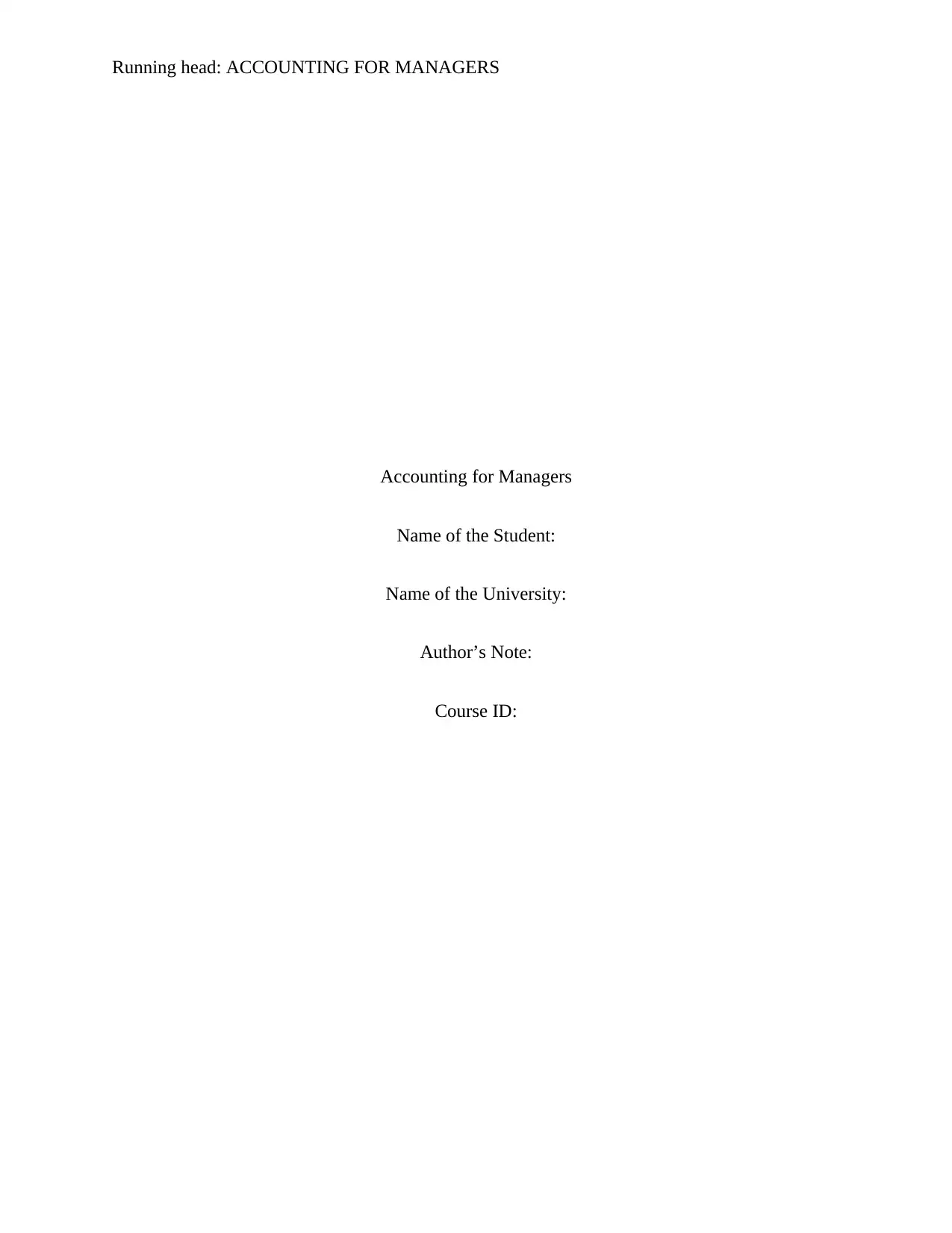
Running head: ACCOUNTING FOR MANAGERS
Accounting for Managers
Name of the Student:
Name of the University:
Author’s Note:
Course ID:
Accounting for Managers
Name of the Student:
Name of the University:
Author’s Note:
Course ID:
Paraphrase This Document
Need a fresh take? Get an instant paraphrase of this document with our AI Paraphraser
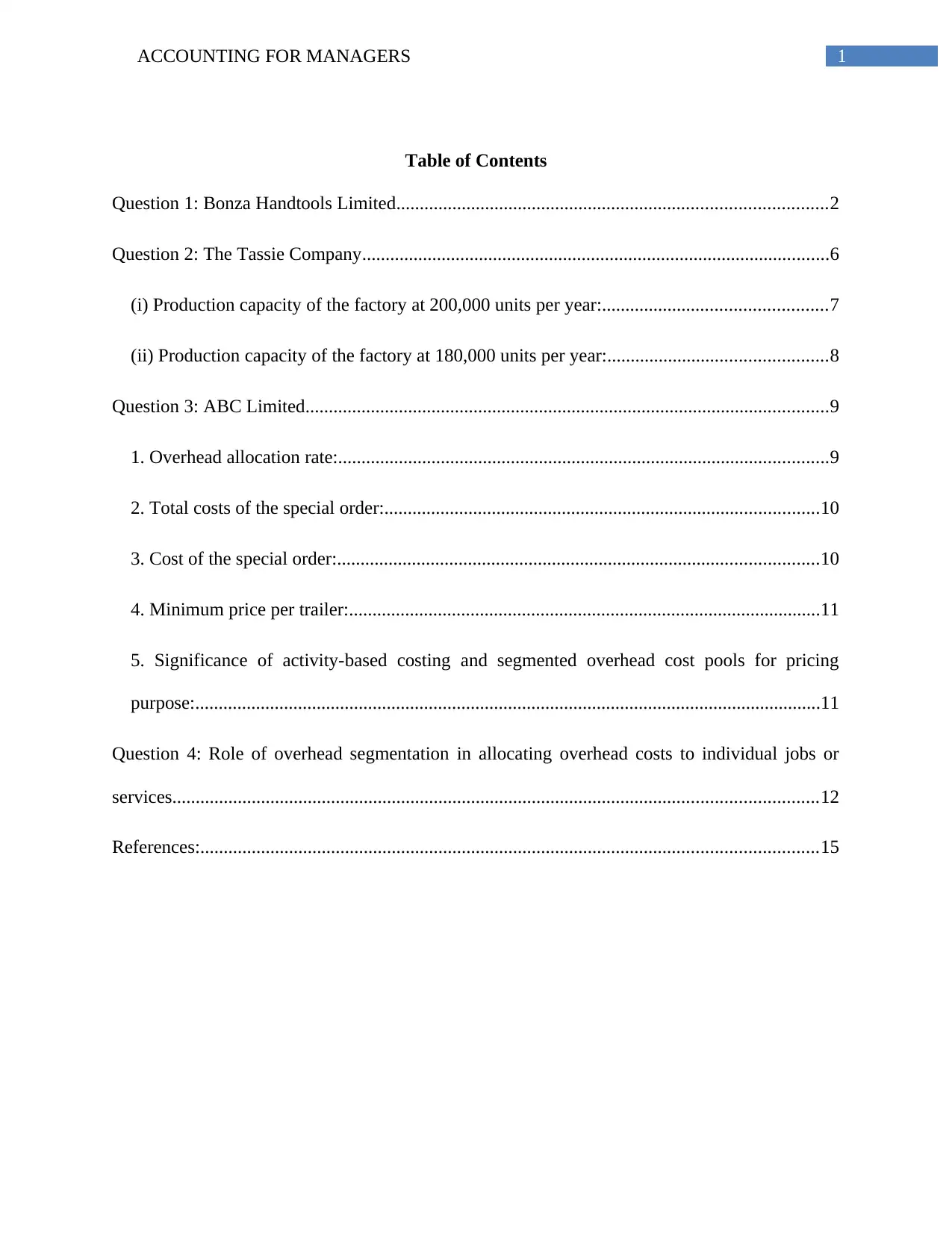
1ACCOUNTING FOR MANAGERS
Table of Contents
Question 1: Bonza Handtools Limited............................................................................................2
Question 2: The Tassie Company....................................................................................................6
(i) Production capacity of the factory at 200,000 units per year:................................................7
(ii) Production capacity of the factory at 180,000 units per year:...............................................8
Question 3: ABC Limited................................................................................................................9
1. Overhead allocation rate:.........................................................................................................9
2. Total costs of the special order:.............................................................................................10
3. Cost of the special order:.......................................................................................................10
4. Minimum price per trailer:.....................................................................................................11
5. Significance of activity-based costing and segmented overhead cost pools for pricing
purpose:......................................................................................................................................11
Question 4: Role of overhead segmentation in allocating overhead costs to individual jobs or
services..........................................................................................................................................12
References:....................................................................................................................................15
Table of Contents
Question 1: Bonza Handtools Limited............................................................................................2
Question 2: The Tassie Company....................................................................................................6
(i) Production capacity of the factory at 200,000 units per year:................................................7
(ii) Production capacity of the factory at 180,000 units per year:...............................................8
Question 3: ABC Limited................................................................................................................9
1. Overhead allocation rate:.........................................................................................................9
2. Total costs of the special order:.............................................................................................10
3. Cost of the special order:.......................................................................................................10
4. Minimum price per trailer:.....................................................................................................11
5. Significance of activity-based costing and segmented overhead cost pools for pricing
purpose:......................................................................................................................................11
Question 4: Role of overhead segmentation in allocating overhead costs to individual jobs or
services..........................................................................................................................................12
References:....................................................................................................................................15

2ACCOUNTING FOR MANAGERS
Question 1: Bonza Handtools Limited
Profitability position of Bonza Handtools Limited for the existing plan and three
alternatives
Particulars Note Details Existing Plan Alternative 1 Alternative 2 Alternative 3
Actual Sales (A) Units Per annum 20,000 20,000 25,000 24,000
Sales (B) Units Beginning 3 months 6,000 6,000 6,000 10,000
Sales (C) Units Remaining Period 14,000 14,000 19,000 14,000
Selling price/unit
(D)
$ Beginning 3 months 130 140 130 120
Selling price/unit
(E)
$ Remaining Period 130 140 130 130
Variable
manufacturing
cost/unit (F)
$ Provided 50 50 55 50
Variable selling
and administrative
cost/unit (G)
$ Provided 30 30 30 30
Total sales (G) $ [(B) x (D) + (C) x
(E)]
2,600,000 2,800,000 3,250,000 3,020,000
Total variable
manufacturing
cost (H)
$ [(A) x (F)] 1,000,000 1,000,000 1,375,000 1,200,000
Total selling and $ [(A) x (G)] 600,000 600,000 750,000 720,000
Question 1: Bonza Handtools Limited
Profitability position of Bonza Handtools Limited for the existing plan and three
alternatives
Particulars Note Details Existing Plan Alternative 1 Alternative 2 Alternative 3
Actual Sales (A) Units Per annum 20,000 20,000 25,000 24,000
Sales (B) Units Beginning 3 months 6,000 6,000 6,000 10,000
Sales (C) Units Remaining Period 14,000 14,000 19,000 14,000
Selling price/unit
(D)
$ Beginning 3 months 130 140 130 120
Selling price/unit
(E)
$ Remaining Period 130 140 130 130
Variable
manufacturing
cost/unit (F)
$ Provided 50 50 55 50
Variable selling
and administrative
cost/unit (G)
$ Provided 30 30 30 30
Total sales (G) $ [(B) x (D) + (C) x
(E)]
2,600,000 2,800,000 3,250,000 3,020,000
Total variable
manufacturing
cost (H)
$ [(A) x (F)] 1,000,000 1,000,000 1,375,000 1,200,000
Total selling and $ [(A) x (G)] 600,000 600,000 750,000 720,000
⊘ This is a preview!⊘
Do you want full access?
Subscribe today to unlock all pages.

Trusted by 1+ million students worldwide
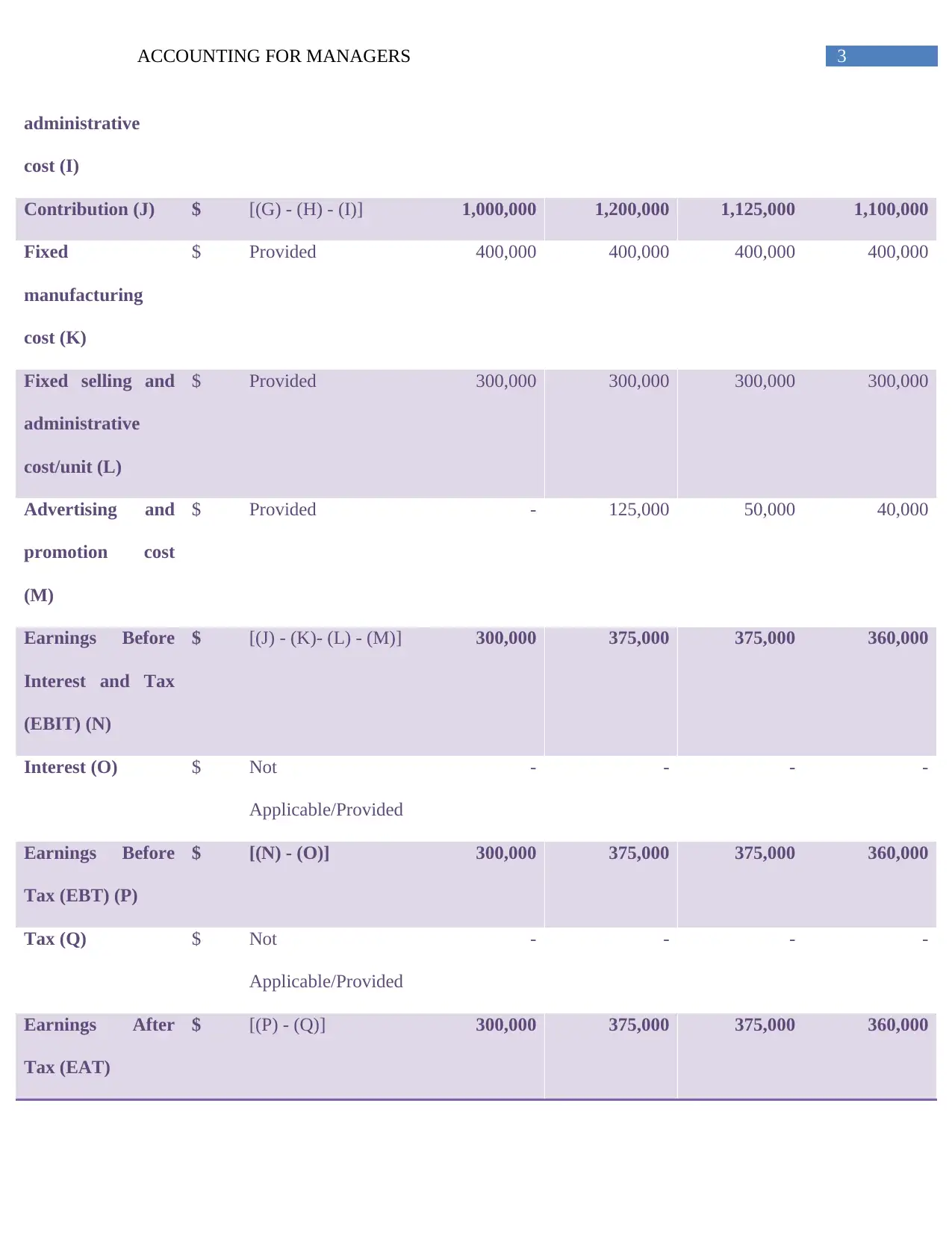
3ACCOUNTING FOR MANAGERS
administrative
cost (I)
Contribution (J) $ [(G) - (H) - (I)] 1,000,000 1,200,000 1,125,000 1,100,000
Fixed
manufacturing
cost (K)
$ Provided 400,000 400,000 400,000 400,000
Fixed selling and
administrative
cost/unit (L)
$ Provided 300,000 300,000 300,000 300,000
Advertising and
promotion cost
(M)
$ Provided - 125,000 50,000 40,000
Earnings Before
Interest and Tax
(EBIT) (N)
$ [(J) - (K)- (L) - (M)] 300,000 375,000 375,000 360,000
Interest (O) $ Not
Applicable/Provided
- - - -
Earnings Before
Tax (EBT) (P)
$ [(N) - (O)] 300,000 375,000 375,000 360,000
Tax (Q) $ Not
Applicable/Provided
- - - -
Earnings After
Tax (EAT)
$ [(P) - (Q)] 300,000 375,000 375,000 360,000
administrative
cost (I)
Contribution (J) $ [(G) - (H) - (I)] 1,000,000 1,200,000 1,125,000 1,100,000
Fixed
manufacturing
cost (K)
$ Provided 400,000 400,000 400,000 400,000
Fixed selling and
administrative
cost/unit (L)
$ Provided 300,000 300,000 300,000 300,000
Advertising and
promotion cost
(M)
$ Provided - 125,000 50,000 40,000
Earnings Before
Interest and Tax
(EBIT) (N)
$ [(J) - (K)- (L) - (M)] 300,000 375,000 375,000 360,000
Interest (O) $ Not
Applicable/Provided
- - - -
Earnings Before
Tax (EBT) (P)
$ [(N) - (O)] 300,000 375,000 375,000 360,000
Tax (Q) $ Not
Applicable/Provided
- - - -
Earnings After
Tax (EAT)
$ [(P) - (Q)] 300,000 375,000 375,000 360,000
Paraphrase This Document
Need a fresh take? Get an instant paraphrase of this document with our AI Paraphraser
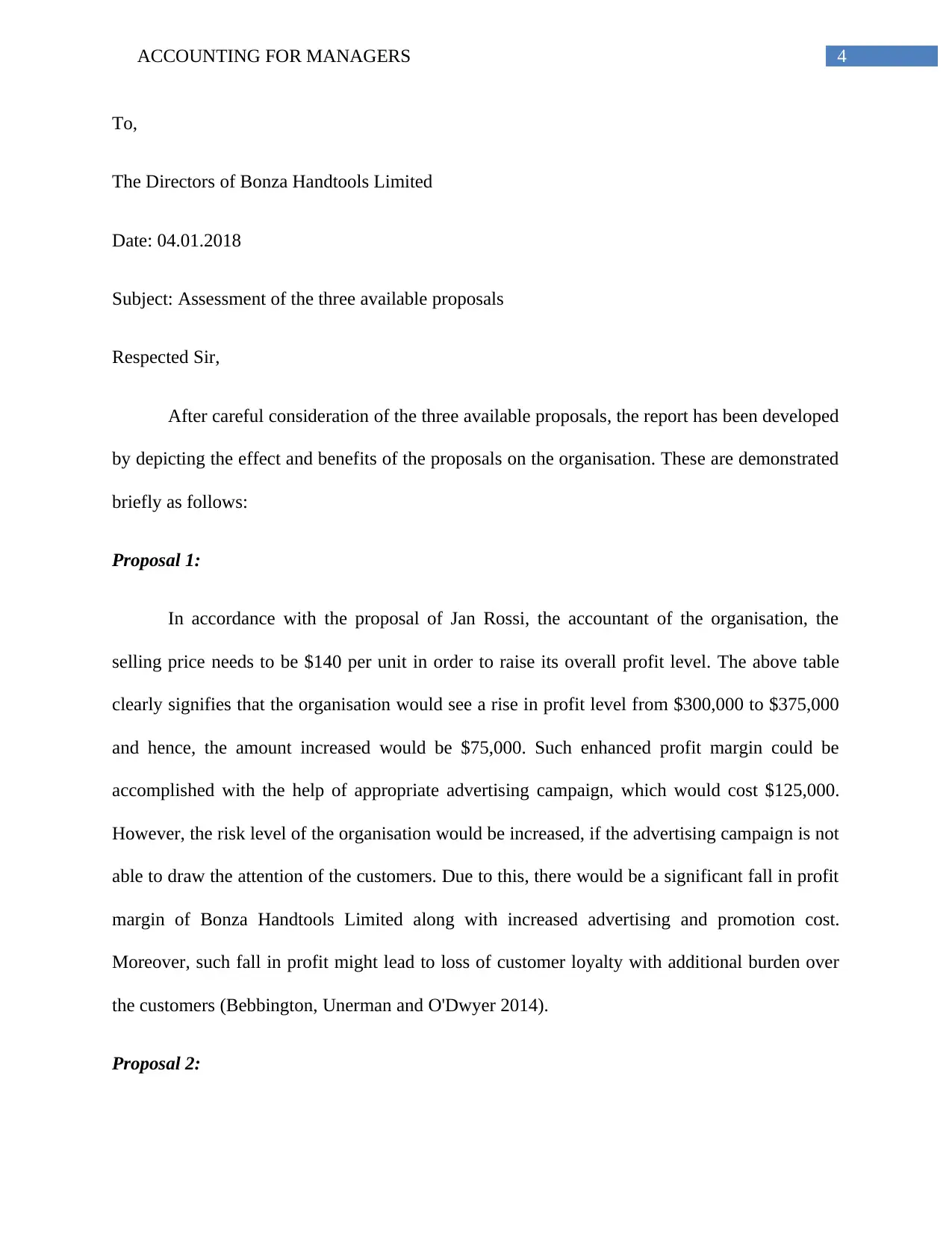
4ACCOUNTING FOR MANAGERS
To,
The Directors of Bonza Handtools Limited
Date: 04.01.2018
Subject: Assessment of the three available proposals
Respected Sir,
After careful consideration of the three available proposals, the report has been developed
by depicting the effect and benefits of the proposals on the organisation. These are demonstrated
briefly as follows:
Proposal 1:
In accordance with the proposal of Jan Rossi, the accountant of the organisation, the
selling price needs to be $140 per unit in order to raise its overall profit level. The above table
clearly signifies that the organisation would see a rise in profit level from $300,000 to $375,000
and hence, the amount increased would be $75,000. Such enhanced profit margin could be
accomplished with the help of appropriate advertising campaign, which would cost $125,000.
However, the risk level of the organisation would be increased, if the advertising campaign is not
able to draw the attention of the customers. Due to this, there would be a significant fall in profit
margin of Bonza Handtools Limited along with increased advertising and promotion cost.
Moreover, such fall in profit might lead to loss of customer loyalty with additional burden over
the customers (Bebbington, Unerman and O'Dwyer 2014).
Proposal 2:
To,
The Directors of Bonza Handtools Limited
Date: 04.01.2018
Subject: Assessment of the three available proposals
Respected Sir,
After careful consideration of the three available proposals, the report has been developed
by depicting the effect and benefits of the proposals on the organisation. These are demonstrated
briefly as follows:
Proposal 1:
In accordance with the proposal of Jan Rossi, the accountant of the organisation, the
selling price needs to be $140 per unit in order to raise its overall profit level. The above table
clearly signifies that the organisation would see a rise in profit level from $300,000 to $375,000
and hence, the amount increased would be $75,000. Such enhanced profit margin could be
accomplished with the help of appropriate advertising campaign, which would cost $125,000.
However, the risk level of the organisation would be increased, if the advertising campaign is not
able to draw the attention of the customers. Due to this, there would be a significant fall in profit
margin of Bonza Handtools Limited along with increased advertising and promotion cost.
Moreover, such fall in profit might lead to loss of customer loyalty with additional burden over
the customers (Bebbington, Unerman and O'Dwyer 2014).
Proposal 2:
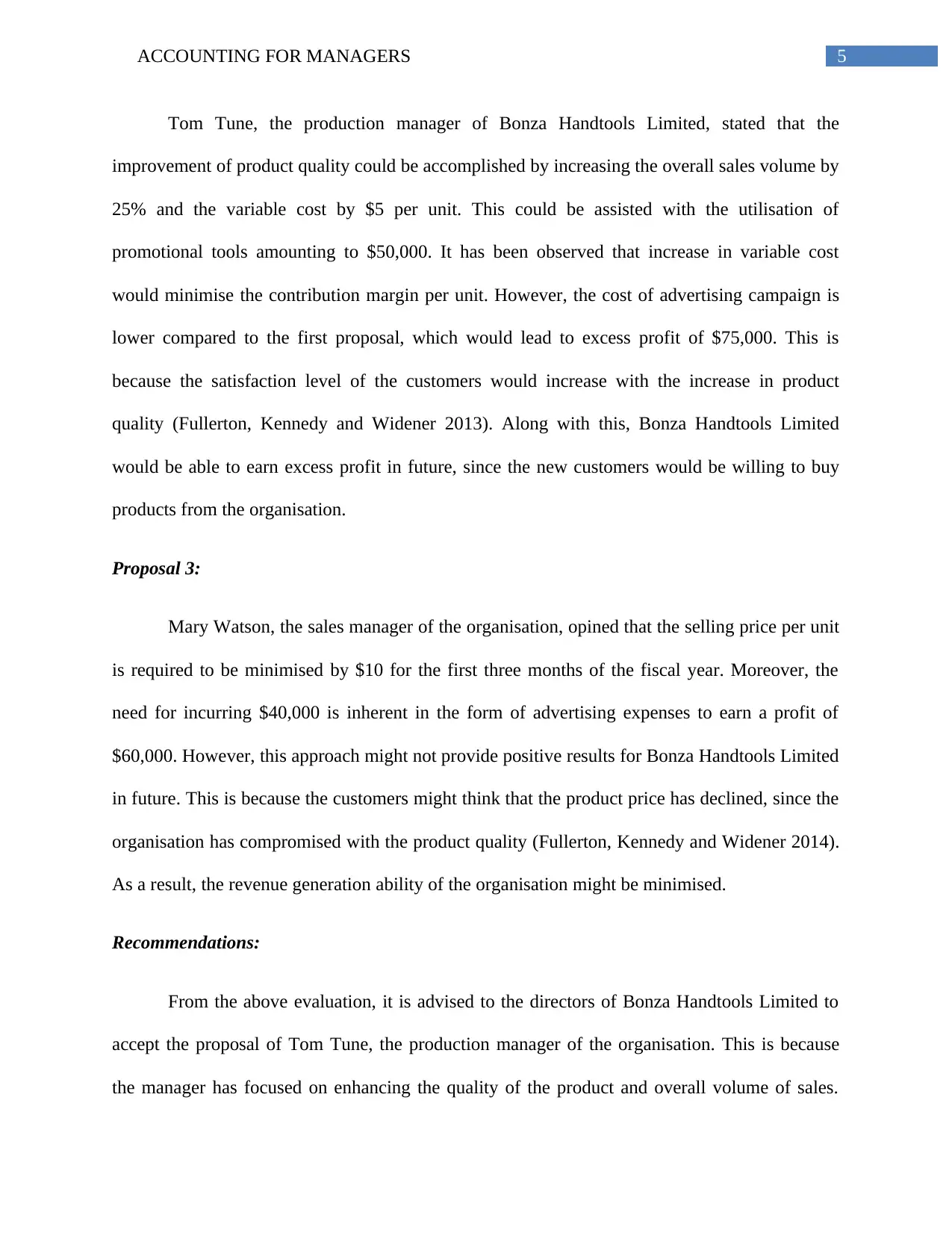
5ACCOUNTING FOR MANAGERS
Tom Tune, the production manager of Bonza Handtools Limited, stated that the
improvement of product quality could be accomplished by increasing the overall sales volume by
25% and the variable cost by $5 per unit. This could be assisted with the utilisation of
promotional tools amounting to $50,000. It has been observed that increase in variable cost
would minimise the contribution margin per unit. However, the cost of advertising campaign is
lower compared to the first proposal, which would lead to excess profit of $75,000. This is
because the satisfaction level of the customers would increase with the increase in product
quality (Fullerton, Kennedy and Widener 2013). Along with this, Bonza Handtools Limited
would be able to earn excess profit in future, since the new customers would be willing to buy
products from the organisation.
Proposal 3:
Mary Watson, the sales manager of the organisation, opined that the selling price per unit
is required to be minimised by $10 for the first three months of the fiscal year. Moreover, the
need for incurring $40,000 is inherent in the form of advertising expenses to earn a profit of
$60,000. However, this approach might not provide positive results for Bonza Handtools Limited
in future. This is because the customers might think that the product price has declined, since the
organisation has compromised with the product quality (Fullerton, Kennedy and Widener 2014).
As a result, the revenue generation ability of the organisation might be minimised.
Recommendations:
From the above evaluation, it is advised to the directors of Bonza Handtools Limited to
accept the proposal of Tom Tune, the production manager of the organisation. This is because
the manager has focused on enhancing the quality of the product and overall volume of sales.
Tom Tune, the production manager of Bonza Handtools Limited, stated that the
improvement of product quality could be accomplished by increasing the overall sales volume by
25% and the variable cost by $5 per unit. This could be assisted with the utilisation of
promotional tools amounting to $50,000. It has been observed that increase in variable cost
would minimise the contribution margin per unit. However, the cost of advertising campaign is
lower compared to the first proposal, which would lead to excess profit of $75,000. This is
because the satisfaction level of the customers would increase with the increase in product
quality (Fullerton, Kennedy and Widener 2013). Along with this, Bonza Handtools Limited
would be able to earn excess profit in future, since the new customers would be willing to buy
products from the organisation.
Proposal 3:
Mary Watson, the sales manager of the organisation, opined that the selling price per unit
is required to be minimised by $10 for the first three months of the fiscal year. Moreover, the
need for incurring $40,000 is inherent in the form of advertising expenses to earn a profit of
$60,000. However, this approach might not provide positive results for Bonza Handtools Limited
in future. This is because the customers might think that the product price has declined, since the
organisation has compromised with the product quality (Fullerton, Kennedy and Widener 2014).
As a result, the revenue generation ability of the organisation might be minimised.
Recommendations:
From the above evaluation, it is advised to the directors of Bonza Handtools Limited to
accept the proposal of Tom Tune, the production manager of the organisation. This is because
the manager has focused on enhancing the quality of the product and overall volume of sales.
⊘ This is a preview!⊘
Do you want full access?
Subscribe today to unlock all pages.

Trusted by 1+ million students worldwide
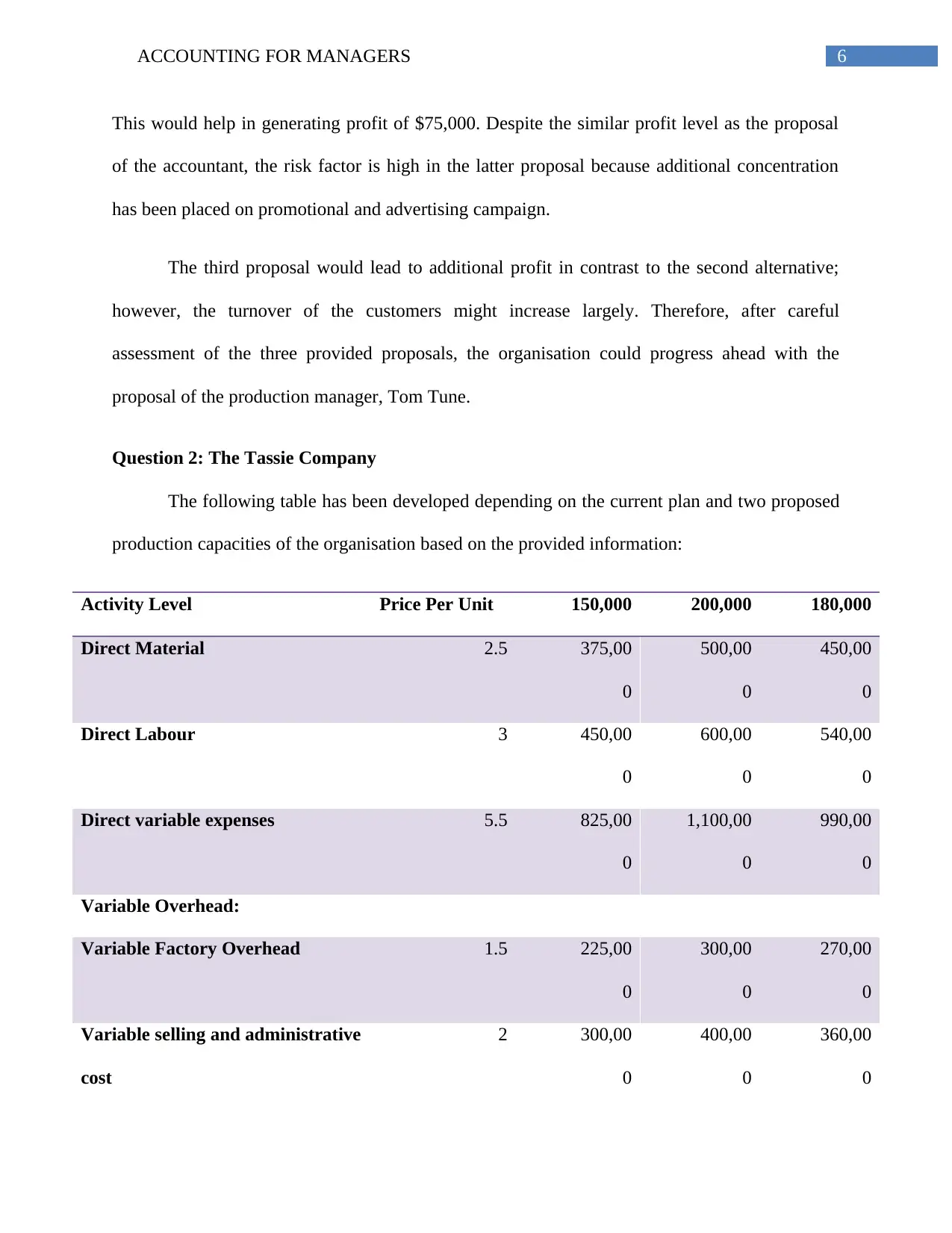
6ACCOUNTING FOR MANAGERS
This would help in generating profit of $75,000. Despite the similar profit level as the proposal
of the accountant, the risk factor is high in the latter proposal because additional concentration
has been placed on promotional and advertising campaign.
The third proposal would lead to additional profit in contrast to the second alternative;
however, the turnover of the customers might increase largely. Therefore, after careful
assessment of the three provided proposals, the organisation could progress ahead with the
proposal of the production manager, Tom Tune.
Question 2: The Tassie Company
The following table has been developed depending on the current plan and two proposed
production capacities of the organisation based on the provided information:
Activity Level Price Per Unit 150,000 200,000 180,000
Direct Material 2.5 375,00
0
500,00
0
450,00
0
Direct Labour 3 450,00
0
600,00
0
540,00
0
Direct variable expenses 5.5 825,00
0
1,100,00
0
990,00
0
Variable Overhead:
Variable Factory Overhead 1.5 225,00
0
300,00
0
270,00
0
Variable selling and administrative
cost
2 300,00
0
400,00
0
360,00
0
This would help in generating profit of $75,000. Despite the similar profit level as the proposal
of the accountant, the risk factor is high in the latter proposal because additional concentration
has been placed on promotional and advertising campaign.
The third proposal would lead to additional profit in contrast to the second alternative;
however, the turnover of the customers might increase largely. Therefore, after careful
assessment of the three provided proposals, the organisation could progress ahead with the
proposal of the production manager, Tom Tune.
Question 2: The Tassie Company
The following table has been developed depending on the current plan and two proposed
production capacities of the organisation based on the provided information:
Activity Level Price Per Unit 150,000 200,000 180,000
Direct Material 2.5 375,00
0
500,00
0
450,00
0
Direct Labour 3 450,00
0
600,00
0
540,00
0
Direct variable expenses 5.5 825,00
0
1,100,00
0
990,00
0
Variable Overhead:
Variable Factory Overhead 1.5 225,00
0
300,00
0
270,00
0
Variable selling and administrative
cost
2 300,00
0
400,00
0
360,00
0
Paraphrase This Document
Need a fresh take? Get an instant paraphrase of this document with our AI Paraphraser
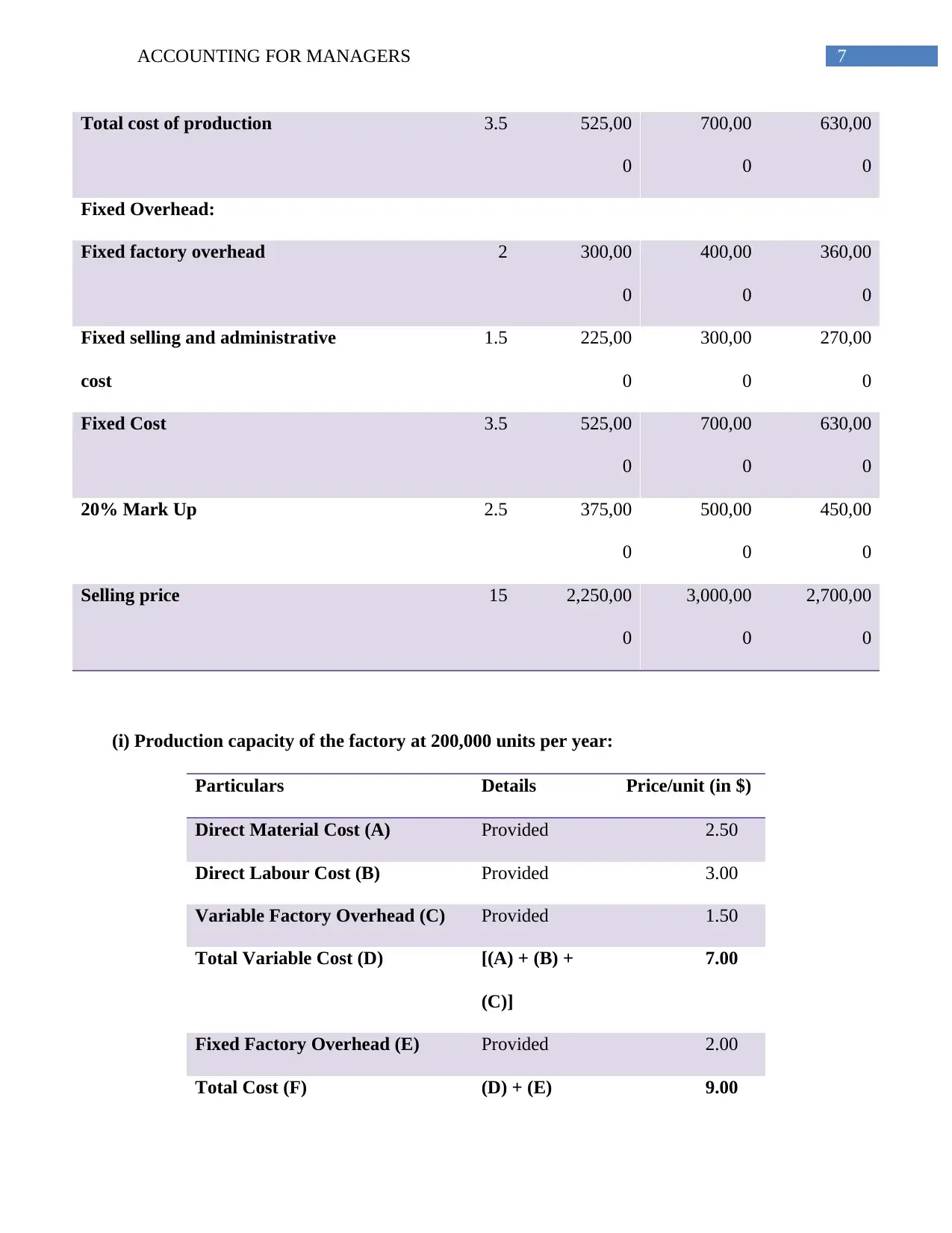
7ACCOUNTING FOR MANAGERS
Total cost of production 3.5 525,00
0
700,00
0
630,00
0
Fixed Overhead:
Fixed factory overhead 2 300,00
0
400,00
0
360,00
0
Fixed selling and administrative
cost
1.5 225,00
0
300,00
0
270,00
0
Fixed Cost 3.5 525,00
0
700,00
0
630,00
0
20% Mark Up 2.5 375,00
0
500,00
0
450,00
0
Selling price 15 2,250,00
0
3,000,00
0
2,700,00
0
(i) Production capacity of the factory at 200,000 units per year:
Particulars Details Price/unit (in $)
Direct Material Cost (A) Provided 2.50
Direct Labour Cost (B) Provided 3.00
Variable Factory Overhead (C) Provided 1.50
Total Variable Cost (D) [(A) + (B) +
(C)]
7.00
Fixed Factory Overhead (E) Provided 2.00
Total Cost (F) (D) + (E) 9.00
Total cost of production 3.5 525,00
0
700,00
0
630,00
0
Fixed Overhead:
Fixed factory overhead 2 300,00
0
400,00
0
360,00
0
Fixed selling and administrative
cost
1.5 225,00
0
300,00
0
270,00
0
Fixed Cost 3.5 525,00
0
700,00
0
630,00
0
20% Mark Up 2.5 375,00
0
500,00
0
450,00
0
Selling price 15 2,250,00
0
3,000,00
0
2,700,00
0
(i) Production capacity of the factory at 200,000 units per year:
Particulars Details Price/unit (in $)
Direct Material Cost (A) Provided 2.50
Direct Labour Cost (B) Provided 3.00
Variable Factory Overhead (C) Provided 1.50
Total Variable Cost (D) [(A) + (B) +
(C)]
7.00
Fixed Factory Overhead (E) Provided 2.00
Total Cost (F) (D) + (E) 9.00
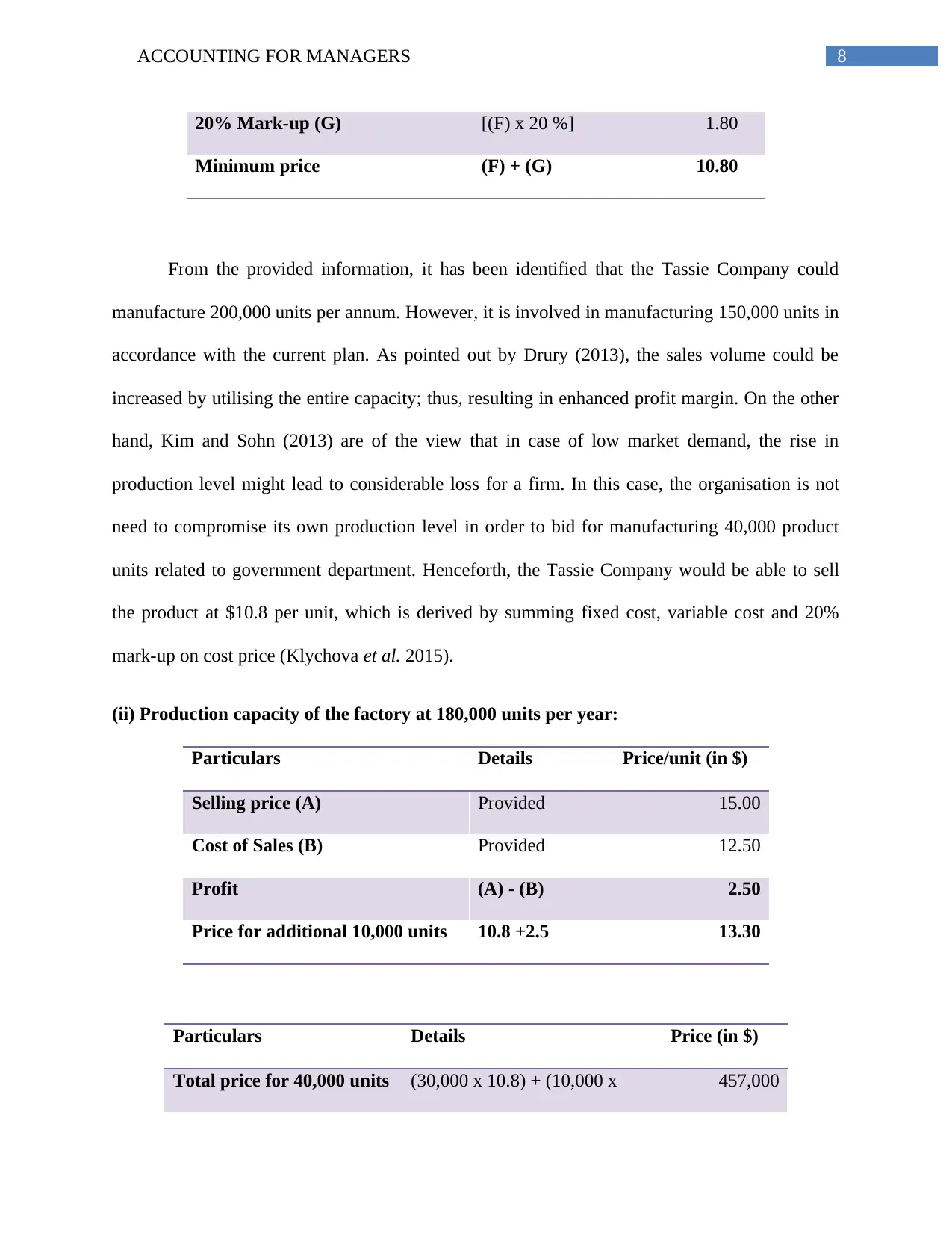
8ACCOUNTING FOR MANAGERS
20% Mark-up (G) [(F) x 20 %] 1.80
Minimum price (F) + (G) 10.80
From the provided information, it has been identified that the Tassie Company could
manufacture 200,000 units per annum. However, it is involved in manufacturing 150,000 units in
accordance with the current plan. As pointed out by Drury (2013), the sales volume could be
increased by utilising the entire capacity; thus, resulting in enhanced profit margin. On the other
hand, Kim and Sohn (2013) are of the view that in case of low market demand, the rise in
production level might lead to considerable loss for a firm. In this case, the organisation is not
need to compromise its own production level in order to bid for manufacturing 40,000 product
units related to government department. Henceforth, the Tassie Company would be able to sell
the product at $10.8 per unit, which is derived by summing fixed cost, variable cost and 20%
mark-up on cost price (Klychova et al. 2015).
(ii) Production capacity of the factory at 180,000 units per year:
Particulars Details Price/unit (in $)
Selling price (A) Provided 15.00
Cost of Sales (B) Provided 12.50
Profit (A) - (B) 2.50
Price for additional 10,000 units 10.8 +2.5 13.30
Particulars Details Price (in $)
Total price for 40,000 units (30,000 x 10.8) + (10,000 x 457,000
20% Mark-up (G) [(F) x 20 %] 1.80
Minimum price (F) + (G) 10.80
From the provided information, it has been identified that the Tassie Company could
manufacture 200,000 units per annum. However, it is involved in manufacturing 150,000 units in
accordance with the current plan. As pointed out by Drury (2013), the sales volume could be
increased by utilising the entire capacity; thus, resulting in enhanced profit margin. On the other
hand, Kim and Sohn (2013) are of the view that in case of low market demand, the rise in
production level might lead to considerable loss for a firm. In this case, the organisation is not
need to compromise its own production level in order to bid for manufacturing 40,000 product
units related to government department. Henceforth, the Tassie Company would be able to sell
the product at $10.8 per unit, which is derived by summing fixed cost, variable cost and 20%
mark-up on cost price (Klychova et al. 2015).
(ii) Production capacity of the factory at 180,000 units per year:
Particulars Details Price/unit (in $)
Selling price (A) Provided 15.00
Cost of Sales (B) Provided 12.50
Profit (A) - (B) 2.50
Price for additional 10,000 units 10.8 +2.5 13.30
Particulars Details Price (in $)
Total price for 40,000 units (30,000 x 10.8) + (10,000 x 457,000
⊘ This is a preview!⊘
Do you want full access?
Subscribe today to unlock all pages.

Trusted by 1+ million students worldwide
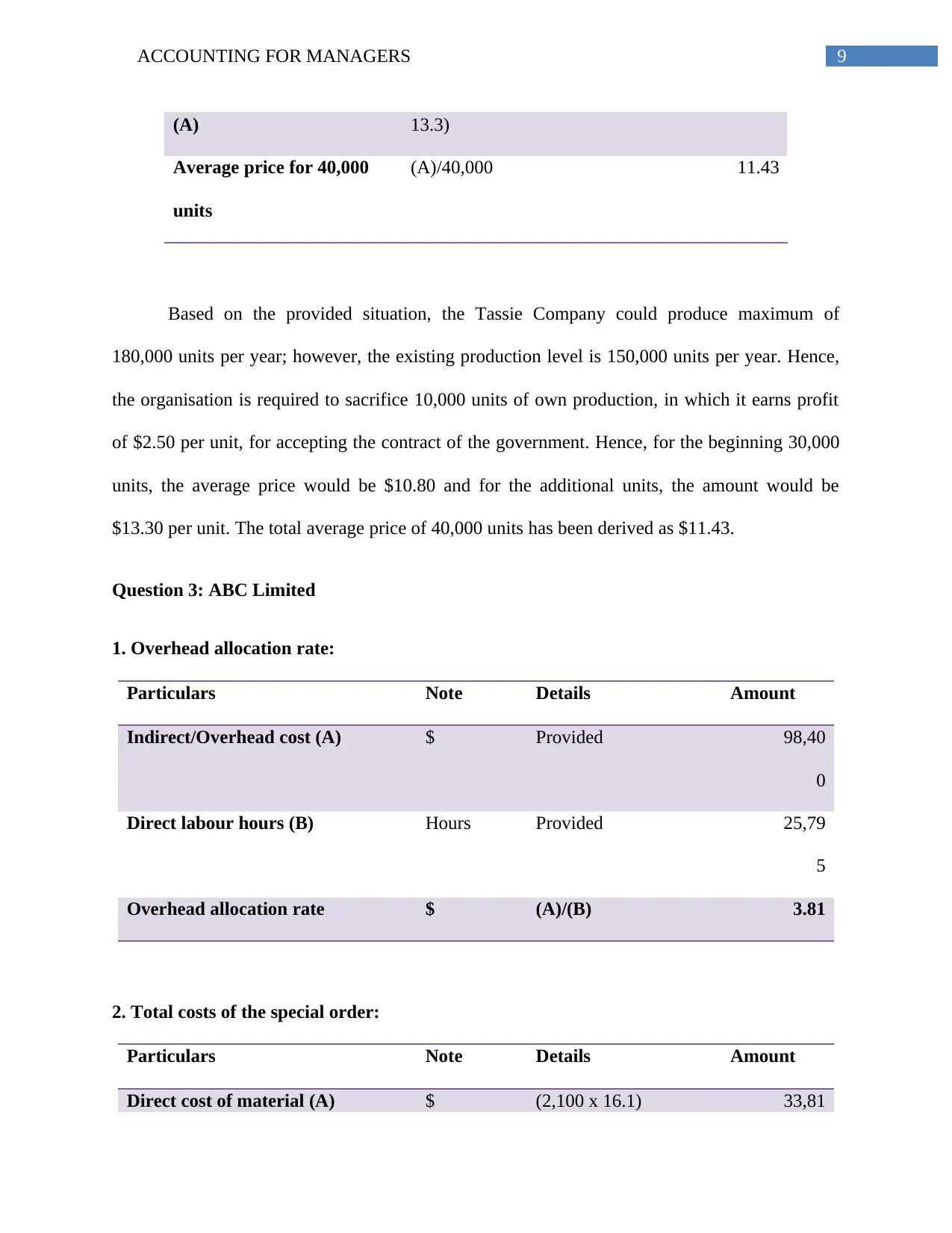
9ACCOUNTING FOR MANAGERS
(A) 13.3)
Average price for 40,000
units
(A)/40,000 11.43
Based on the provided situation, the Tassie Company could produce maximum of
180,000 units per year; however, the existing production level is 150,000 units per year. Hence,
the organisation is required to sacrifice 10,000 units of own production, in which it earns profit
of $2.50 per unit, for accepting the contract of the government. Hence, for the beginning 30,000
units, the average price would be $10.80 and for the additional units, the amount would be
$13.30 per unit. The total average price of 40,000 units has been derived as $11.43.
Question 3: ABC Limited
1. Overhead allocation rate:
Particulars Note Details Amount
Indirect/Overhead cost (A) $ Provided 98,40
0
Direct labour hours (B) Hours Provided 25,79
5
Overhead allocation rate $ (A)/(B) 3.81
2. Total costs of the special order:
Particulars Note Details Amount
Direct cost of material (A) $ (2,100 x 16.1) 33,81
(A) 13.3)
Average price for 40,000
units
(A)/40,000 11.43
Based on the provided situation, the Tassie Company could produce maximum of
180,000 units per year; however, the existing production level is 150,000 units per year. Hence,
the organisation is required to sacrifice 10,000 units of own production, in which it earns profit
of $2.50 per unit, for accepting the contract of the government. Hence, for the beginning 30,000
units, the average price would be $10.80 and for the additional units, the amount would be
$13.30 per unit. The total average price of 40,000 units has been derived as $11.43.
Question 3: ABC Limited
1. Overhead allocation rate:
Particulars Note Details Amount
Indirect/Overhead cost (A) $ Provided 98,40
0
Direct labour hours (B) Hours Provided 25,79
5
Overhead allocation rate $ (A)/(B) 3.81
2. Total costs of the special order:
Particulars Note Details Amount
Direct cost of material (A) $ (2,100 x 16.1) 33,81
Paraphrase This Document
Need a fresh take? Get an instant paraphrase of this document with our AI Paraphraser
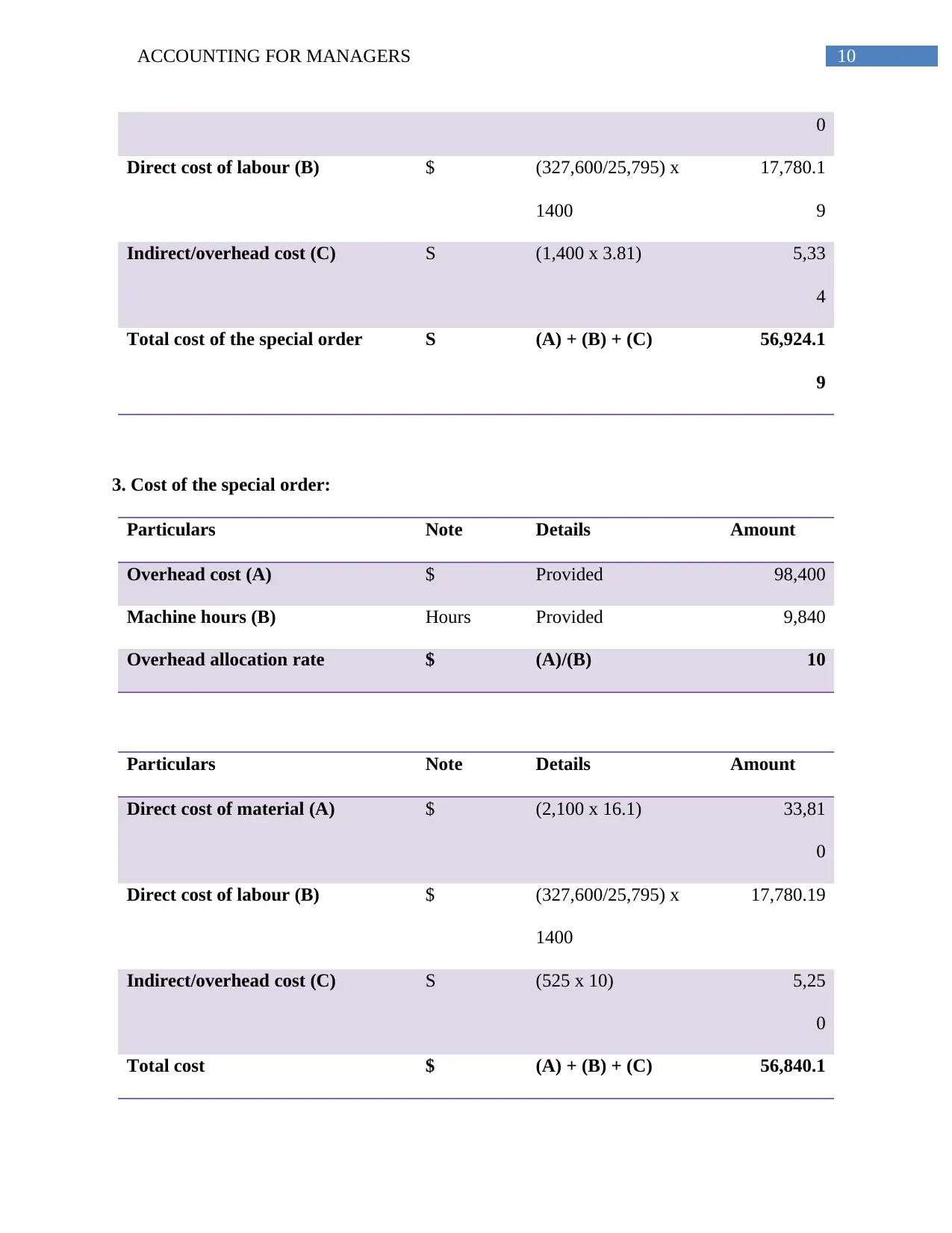
10ACCOUNTING FOR MANAGERS
0
Direct cost of labour (B) $ (327,600/25,795) x
1400
17,780.1
9
Indirect/overhead cost (C) S (1,400 x 3.81) 5,33
4
Total cost of the special order S (A) + (B) + (C) 56,924.1
9
3. Cost of the special order:
Particulars Note Details Amount
Overhead cost (A) $ Provided 98,400
Machine hours (B) Hours Provided 9,840
Overhead allocation rate $ (A)/(B) 10
Particulars Note Details Amount
Direct cost of material (A) $ (2,100 x 16.1) 33,81
0
Direct cost of labour (B) $ (327,600/25,795) x
1400
17,780.19
Indirect/overhead cost (C) S (525 x 10) 5,25
0
Total cost $ (A) + (B) + (C) 56,840.1
0
Direct cost of labour (B) $ (327,600/25,795) x
1400
17,780.1
9
Indirect/overhead cost (C) S (1,400 x 3.81) 5,33
4
Total cost of the special order S (A) + (B) + (C) 56,924.1
9
3. Cost of the special order:
Particulars Note Details Amount
Overhead cost (A) $ Provided 98,400
Machine hours (B) Hours Provided 9,840
Overhead allocation rate $ (A)/(B) 10
Particulars Note Details Amount
Direct cost of material (A) $ (2,100 x 16.1) 33,81
0
Direct cost of labour (B) $ (327,600/25,795) x
1400
17,780.19
Indirect/overhead cost (C) S (525 x 10) 5,25
0
Total cost $ (A) + (B) + (C) 56,840.1
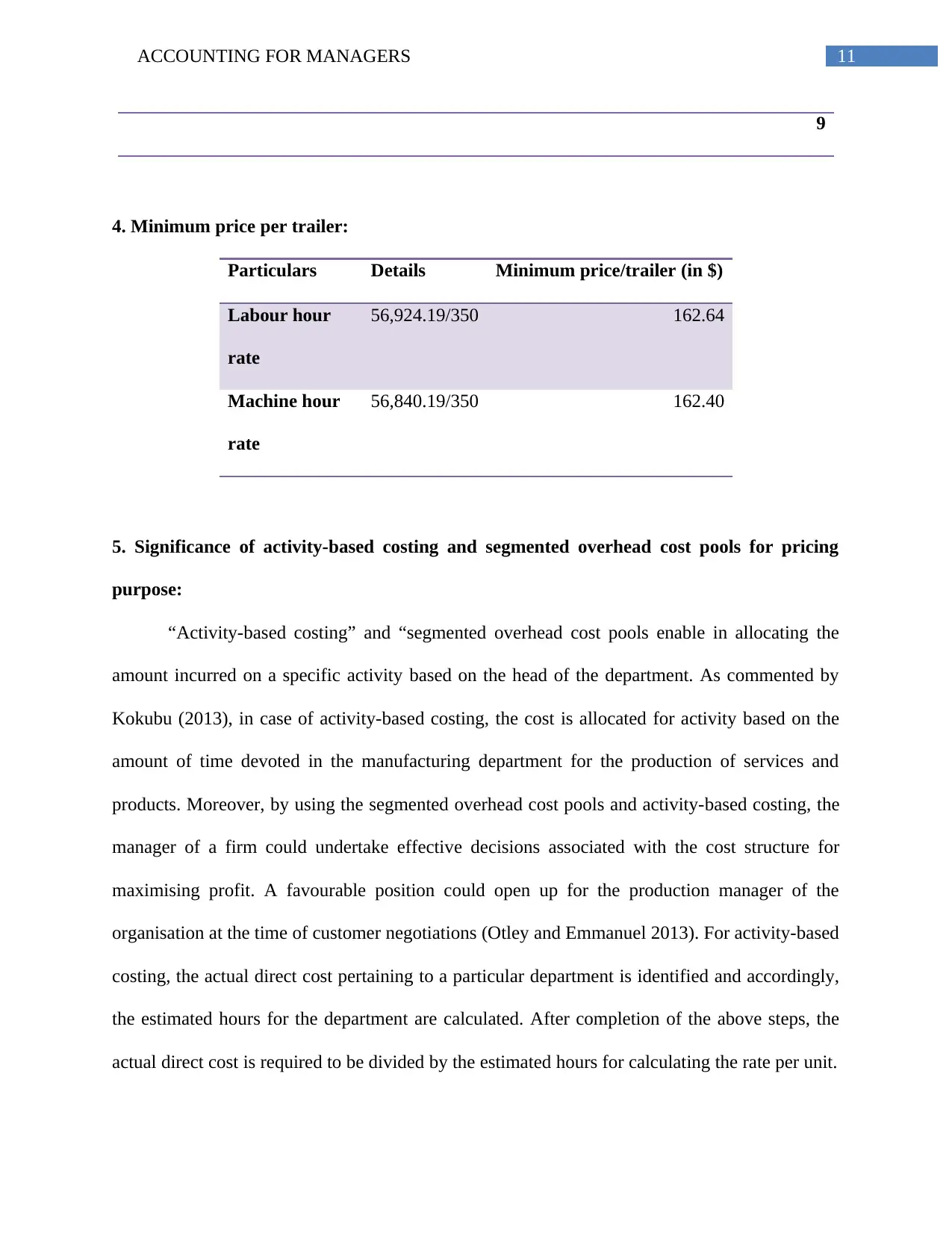
11ACCOUNTING FOR MANAGERS
9
4. Minimum price per trailer:
Particulars Details Minimum price/trailer (in $)
Labour hour
rate
56,924.19/350 162.64
Machine hour
rate
56,840.19/350 162.40
5. Significance of activity-based costing and segmented overhead cost pools for pricing
purpose:
“Activity-based costing” and “segmented overhead cost pools enable in allocating the
amount incurred on a specific activity based on the head of the department. As commented by
Kokubu (2013), in case of activity-based costing, the cost is allocated for activity based on the
amount of time devoted in the manufacturing department for the production of services and
products. Moreover, by using the segmented overhead cost pools and activity-based costing, the
manager of a firm could undertake effective decisions associated with the cost structure for
maximising profit. A favourable position could open up for the production manager of the
organisation at the time of customer negotiations (Otley and Emmanuel 2013). For activity-based
costing, the actual direct cost pertaining to a particular department is identified and accordingly,
the estimated hours for the department are calculated. After completion of the above steps, the
actual direct cost is required to be divided by the estimated hours for calculating the rate per unit.
9
4. Minimum price per trailer:
Particulars Details Minimum price/trailer (in $)
Labour hour
rate
56,924.19/350 162.64
Machine hour
rate
56,840.19/350 162.40
5. Significance of activity-based costing and segmented overhead cost pools for pricing
purpose:
“Activity-based costing” and “segmented overhead cost pools enable in allocating the
amount incurred on a specific activity based on the head of the department. As commented by
Kokubu (2013), in case of activity-based costing, the cost is allocated for activity based on the
amount of time devoted in the manufacturing department for the production of services and
products. Moreover, by using the segmented overhead cost pools and activity-based costing, the
manager of a firm could undertake effective decisions associated with the cost structure for
maximising profit. A favourable position could open up for the production manager of the
organisation at the time of customer negotiations (Otley and Emmanuel 2013). For activity-based
costing, the actual direct cost pertaining to a particular department is identified and accordingly,
the estimated hours for the department are calculated. After completion of the above steps, the
actual direct cost is required to be divided by the estimated hours for calculating the rate per unit.
⊘ This is a preview!⊘
Do you want full access?
Subscribe today to unlock all pages.

Trusted by 1+ million students worldwide
1 out of 17
Related Documents
Your All-in-One AI-Powered Toolkit for Academic Success.
+13062052269
info@desklib.com
Available 24*7 on WhatsApp / Email
![[object Object]](/_next/static/media/star-bottom.7253800d.svg)
Unlock your academic potential
Copyright © 2020–2025 A2Z Services. All Rights Reserved. Developed and managed by ZUCOL.



